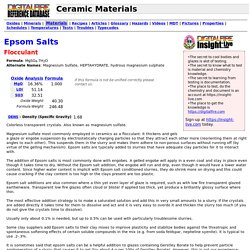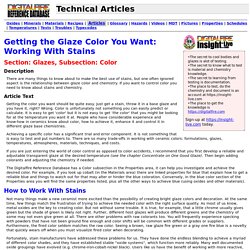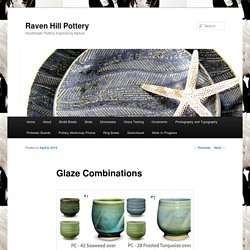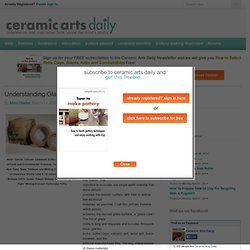

Epsom Salts. Oxides | Minerals | Materials | Recipes | Articles | Glossary | Hazards | Videos | MDT | Pictures | Properties | Schedules | Temperatures | Tests | Troubles | Typecodes •The secret to cool bodies and glazes is alot of testing.

•The secret to know what to test is material and chemistry knowledge. •The secret to learning from testing is documentation. •The place to test, do the chemistry and document is an account at •The place to get the knowledge is Flocculant Formula: MgSO4.7H2OAlternate Names: Magnesium Sulfate, HEPTAHYDRATE, hydrous magnesium sulphate Colorless transparent crystals. Magnesium sulfate most commonly employed in ceramics as a flocculant. The addition of Epsom salts is most commonly done with engobes. Epsom salt additions are also common where a thin yet even layer of glaze is required, such as with low fire transparent glazed earthenware. The most effective addition strategy is to make a saturated solution and add this in very small amounts to a slurry. Pictures. Getting the Glaze Color You Want: Working With Stains.
Oxides | Minerals | Materials | Recipes | Articles | Glossary | Hazards | Videos | MDT | Pictures | Properties | Schedules | Temperatures | Tests | Troubles | Typecodes •The secret to cool bodies and glazes is alot of testing.

•The secret to know what to test is material and chemistry knowledge. •The secret to learning from testing is documentation. •The place to test, do the chemistry and document is an account at •The place to get the knowledge is Section: Glazes, Subsection: Color Description There are many things to know about to make the best use of stains, but one often ignored aspect is the relationship between glaze color and chemistry. Article Text Getting the color you want should be quite easy. Achieving a specific color has a significant trial and error component. The Digitalfire Reference Database has a Color subsection in the Properties area, it can help you investigate and achieve the desired color. How to Work With Stains For example here is a report on a generic stain type: Glaze Combinations. Here’s some of the glaze combinations I’m wanting to try on my bottles and vases, especially the simple, clean line forms.

However, I think these could look great on the pieces with the handles too. Here’s a look at the sketches from yesterday’s post, just in case you missed it. #1 Seaweed over True Celadon is absolutely gorgeous #2 Frosted Turquoise over True Celadon is wonderful #3 Lustrous Jade over True Celadon is really nice #4 Arctic Blue over True Celadon is nice Oh, my goodness! I feel like a kid in the candy store. . #1 Art Deco Green over True Celadon is absolutely gorgeous. Glaze recipes. Understanding Glazes Through Raw Materials: Using Glaze Cores.
This article was excerpted from Ceramic Raw Materials: Understanding Ceramic Glaze Ingredients and Clay Making Materials, which is free to Ceramic Arts Daily subscribers.

Feldspars and Rocks: Stoneware test pots by Barbara Beck, fired to cone 9–10 reduction. Glaze: Feldspar 90%, Whiting 10%, Red iron oxide, ½%. Pots, left to right: Potash feldspar, Cornwall Stone, Soda feldspar. Pot, rear, center: Nepheline Syenite. Rocks, left to right: Soda feldspar, Potash feldspar, Nepheline Syenite, Cornwall Stone. Feldspars and feldspathic rocks contain a complex structure of silica, alumina, and the melter oxides of sodium, potassium, and calcium.
Left: Granite. OriginThroughout earth’s history, violent upheavals have forced silica-rich magma up toward the earth’s outer layers. General Characteristics of FeldsparsFeldspar includes an assortment of minerals of varying composition. 1. Glazing and Firing Techniques Atmospheric-like Effects in an Electric Kiln.
Low Budget Glaze Spraying: Using an Atomizer for Great Ceramic Glazing Effects. Learn more about glaze spraying… Steven Hill has developed one of the most amazing sprayed glazing techniques any clay lover would be proud to use — even just part of it.

After spending more than four decades perfecting his glazes and spraying techniques, Steven shares his recipes and walks you step-by-step through the process for achieving rich organic surfaces in his DVD Surface Techniques. Whether you use the entire process or any part of it, you’ll be amazed at the possibilities. Learn more and watch an excerpt! To learn more about Patricia Bridges or to see more images of her work, please visit www.bridgespottery.com. For more interesting ceramic glazing techniques, download your free copy of Four Great Ceramic Glazing Techniques: How to Formulate Successful Crystalline Glazes, add Depth Through Carving and Layering, and Glaze in the Majolica Style.
Click here to leave a comment.